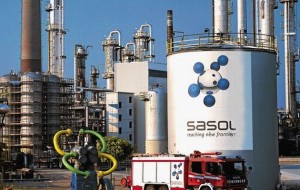Johannesburg – South Africa’s petrochemical giant, Sasol is seeking project finance and loans, and may also sell bonds in the US, to fund a petrochemical plant in Louisiana costing as much as $7 billion, the chief executive officer said.
Sasol needs to raise $5 billion to $7 billion to build a cracker near Lake Charles, Louisiana, which will convert ethane natural gas to ethylene, used to produce raw materials for goods such as paint and detergents, and start up in 2017, chief executive David Constable said.
“We’ll look at some project financing as well as most likely some US bonds,” Constable, 51, said in a Sept. 9 interview from Johannesburg, where the company is based.
“We’re comfortable with our ability to fund.”
The hunt for cash comes against a backdrop of see-sawing markets that drove Sasol’s November 2022 bond yield to a record 6.2 percent on September 5, before falling 27 basis points since then.
The average rate for dollar debt of emerging-market oil and gas companies has dropped 16 basis points in the period, JPMorgan Chase & Co. indexes show.
While Sasol, rated BBB at Standard & Poor’s, has yet to arrange any loans for the project, similarly rated Glencore Xstrata Plc, a global commodities trader, paid 90 basis points more than benchmark rates on the three-year portion of its $17.3 billion financing earlier this year, according to data compiled by Bloomberg.
BBB is the second-lowest investment grade at S&P. Sasol didn’t respond to an e-mailed request for comment sent after business hours on September 13.
Yield Increase
The cracker will precede a facility that will convert gas to liquid fuel, the first of its kind in the US, which will cost as much as $14 billion.
Sasol, the world’s biggest producer of motor fuel from coal, will make the final investment decision on the cracker in 2014, and the verdict for the gas-to-liquids plant, which will also be in Louisiana, will follow 18 months to 24 months later.
Project financing involves lenders being repaid from a specific project’s revenue and having no claim on other assets.
Borrowing costs for emerging-market companies have been rising in the past three months as the Federal Reserve considers curtailing record stimulus, signaling a reduction in the flood of cheap money that has propped up assets prices from South Africa to Singapore.
The extra yield that buyers demand to own dollar- denominated emerging-market debt instead of Treasuries climbed 45 basis points, or 0.45 percentage point, this year to 359 basis points on September 13, JPMorgan indexes show.
Testing Waters
“We can clearly see that there is a decrease in appetite for emerging-market risk,” Simon Redmond, a London-based credit analyst at S&P, said by phone on September 10.
“While there may be some increase in the cost of funding for Sasol, I don’t think that the movements we’ve seen in the markets are currently a cause for concern in terms of any potential future debt issues. It depends on how far some of these trends run.”
Sasol sold $1 billion of bonds in its first offer in the US currency in November.
“We were testing the water and seeing what appetite there was,” Constable said.
“The response was strong and that means bond investors support our long-term strategy, which is very good for us.”
The gas for the plant, which will produce 1.5 million metric tons of ethylene annually, will come from fields using hydraulic fracturing, or fracking, a process in which millions of gallons of water, sand and chemicals are pumped underground to break apart a rock formation and release natural gas.
The ethylene will be used in satellite plants on the same site to produce the raw materials for products including soft-drink cans and detergents, Constable said.
Cost Estimates
Sasol will probably reach final cost estimates in February or March, he said. It will start talking to contractors and banks at the end of this year before lining up funding in 2014.
“There is some headroom to increase debt but if we look at that on a cash-flow cover basis, there could be a risk if the operating performance deteriorates once investment in the project has started,” S&P’s Redmond said.
“The leverage measures start to look a bit weaker.”
Shale Gas
Sasol decided to build the plant in the US because of the country’s abundance of shale gas, Constable said.
The company would consider building a similar operation in South Africa if the government permitted environmentally friendly shale-gas extraction with the right regulatory framework, he said.
South Africa’s rand has slipped 14 percent against the dollar this year, making it the worst performer among 16 major currencies tracked by Bloomberg.
The rand gained 1.4 percent to 9.7911 per dollar by 10:06 a.m. in Johannesburg. Yields on the government’s rand bonds due December 2026 have climbed 78 basis points this year to 8.07 percent.
“The ethane coming off shale gas puts us way down on the cost curve,” Constable said.
“The US is going to stay there for some decades to come.”
Once the plants are built, they will convert natural gas into 4 million tons a year, or 96,000 barrels a day, of transport fuel including gas-to-liquids diesel.
Sasol’s expertise in converting gas and coal into fuel comes from South Africa’s apartheid era, when the country faced sanctions on importing oil.
“We’re quite comfortable with the different options in front of us,” Constable said.
“We’ll keep a close eye on the bond market obviously.” – Bloomberg News



